Introduction of Implementation Customer
Supporting research, development, education and training for ship-related environmental issues, energy efficiency and safe navigation.
- Place of Implementation
-
Tokyo University of Marine Science and Technology,
Faculty of Marine Technology, Department of Maritime Systems Engineering
- Locations
-
Shinagawa (Minato-ku, Tokyo) , Etchujima (Koto-ku, Tokyo)
- University philosophy
-
To engage in basic and applied education and research activities relating to scholarship, science and technology concerned with the ocean, and thereby to contribute to the sustainable development of human society.
Pre-implementation Tasks
A completely new research facility was needed that would support research, development, education and training for finding solutions to ship-related issues.
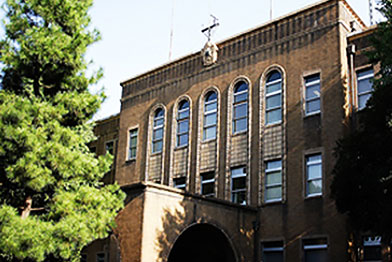
(Etchujima Campus)
While safe navigation is a primary concern in ship operation, there are various other issues as well, such as energy-efficient navigation, environmental protection and anti-piracy measures.
Tokyo University of Marine Science and Technology (TUMSAT) is a center of groundbreaking marine-related education and research that is engaged in advanced studies in ship operation science and technology fields, in search of solutions to the diverse issues facing ships today both in Japan and worldwide.
The university was seeking to develop a new research facility that would support ship operation-related research, development, education and training for the cultivation of the engineer with advanced technologies and researchers who will take the lead in the “ship operation science and technology” field of the future.
Implementation Issues and Resolution Procedures
Comprehensive information gathering and analysis of ship condition, weather and ocean conditions, marine traffic flow and other matters.
Support for concerns as diverse as environmental issues, energy efficiency, the acceleration of logistics and transport, and safe navigation-related anti-piracy measures necessitates that information pertaining to ship condition, weather and ocean condition, marine traffic flow and other matters be comprehensively gathered and analyzed, and that ship-appropriate advice be provided.
Integration of all types of information
- Onshore radar stations (Tokyo Bay radar images)
- Onshore AIS stations (Tokyo Bay ship information)
- “Shioji Maru”, the TUMSAT training ship (radar images, voyage information, mechanical information, web cameras)
- Weather information (Kyoto University weather support website)
If it becomes possible to share this gathered, managed and analyzed information among researchers, research and development in the maritime field will improve in quality, and further growth in the research and development of new ship operation technologies can be anticipated.
With GIS implementation, all types of gathered information are layered and displayed superimposed, which makes it possible to coordinate information on weather, ocean conditions and the ship movement situation. Research to remove or reduce many of the issues relating to ship operation can be anticipated to accelerate.
Post-implementation Effects
Development of J-Marine GIS Advanced Navigation System
JRC developed the “J-Marine GIS Advanced Navigation System”, which can be used to study trainee grasp of training ship handling conditions, as well as various matters including analysis of ship movement in Tokyo Bay, optimal ship route simulation, and risk assessment and verification.
The Advanced Navigation System creates databases of all types of information gathered as necessary from onshore radar stations, onshore AIS stations, ships and weather support sites, and displays this information on multiple monitors and computers.
The Advanced Navigation System is equipped with functionality that can show information on ships in Tokyo Bay, real-time display that aids in grasping ship movement conditions within the bay, and playback capability for redisplaying previous conditions. It is also used for instruction on confirming the wake of the training ship and observing changes in marine traffic flow.
The Advanced Navigation System is made up of servers on a network installed primarily at the university. The training ship uses a satellite connection, and wireless LAN when docked, and each site in Tokyo Bay connects via onshore internet networks and maintains a VPN. The system is built on a dedicated intranet within the university, and as all types of information in the database can be downloaded as data for researcher analysis and testing, information sharing between researchers has been realized.
- Implementation of marine GIS
The system is equipped with marine GIS functionality, featuring superimposed displays of weather and ocean condition information with all types of gathered information. Combination (layer selection) of data types selected according to the research objective with multiple information samples is now easily performed, and visual recognition of analysis and testing results is available as well. Moreover, with the measurement tools that are a basic GIS feature, it is now possible to carry out measurements of route distance and area. - Tokyo Bay current condition display
By displaying radar images from onshore radar stations and ship information from AIS receiving stations, it is possible to grasp the situation of ship movement in Tokyo Bay. - Weather and ocean condition information display
Information on wave value predictions announced by the Meteorological Agency is displayed here, making it possible to estimate effects on ships. - Ship information display
Ship information gathered through Tokyo University of Marine Science and Technology training ship’s internal network is acquired via satellite connection, and ship handling conditions and mechanical operation conditions can be observed by displaying in real time. IP phone and videoconferencing communication equipment is available as well.
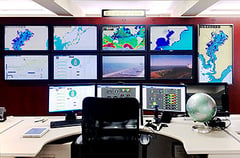
View of Advanced Navigation System

Display Examples on Monitors
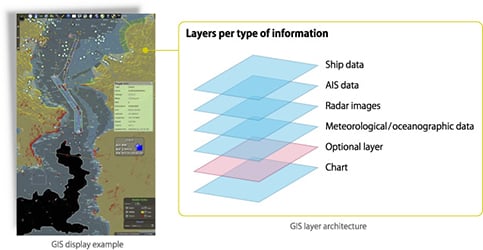
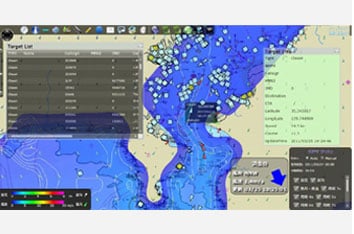
Tokyo Bay AIS information display
Interview with Professor Ruri Shoji, Tokyo University of Marine Science and Technology
“Collision risk assessment in real time based on SJ value” and “Making visible” using the Advanced Navigation System
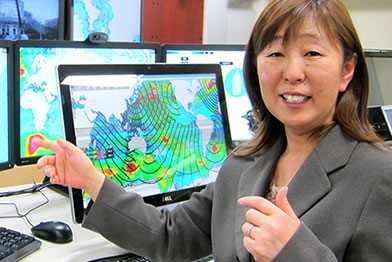
Chair of Department of Maritime Systems Engineering, Faculty of Marine Technology
At present, we are working with the Advanced Navigation System to conduct research on collision risk of ships navigating Tokyo Bay, using SJ values applied in real time.
We calculate the SJ values using AIS data location information and ship information gathered by the Advanced Navigation System, and collision risk assessment results are displayed on Advanced Navigation System GIS screen as seven color-coded levels, from +3 (very safe) to -3 (very dangerous). As a result, we are now able to grasp at a glance the level of risk of ships navigating Tokyo Bay.
The greatest advantage of the Advanced Navigation System is that new research and system development can be carried out using the information it gathers and manages, and that those results can then be applied in the Advanced Navigation System.
Overlaying the SJ value layer on the Tokyo Bay real-time ship information layer makes it possible to engage in more practical research.
What is SJ value?
It is an indicator used to judge the subjective collision risk felt by a ship operator when coming within range of another ship.
SJ value = “Sub. Judgment” value (subjective collision risk)
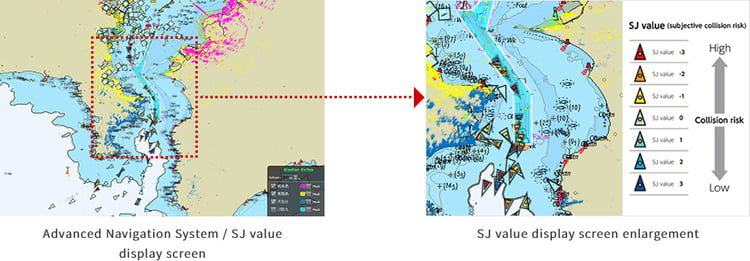
Implementation Product System
J-Marine GIS Advanced Navigation System
This is a research system that gathers, manages, analyzes and displays a broad spectrum of ship operation-related information in an efficient and integrated manner, and that provides support for operation-related research, development, education and training.
* The contents of this implementation example are current as of April 2016.
